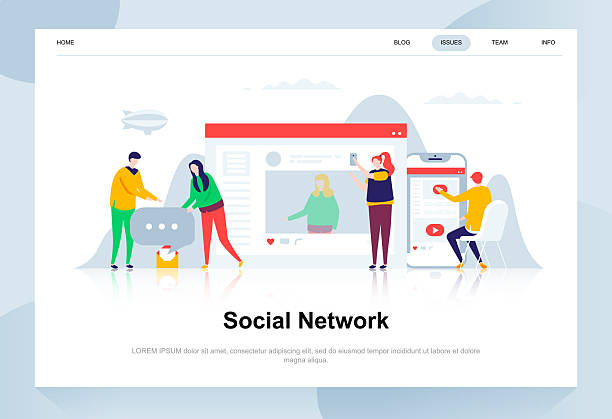The Fundamental Importance of Secure Website Design in the Digital Age

In today’s world, where physical borders are fading and businesses are moving towards digitalization, the importance of #Secure_Website_Design is more palpable than ever.
A website is the beating heart of any online activity, and protecting it against #Cyber_Attacks not only ensures business stability but also significantly helps maintain #User_Trust.
Failure to adhere to Website_Security principles can lead to the loss of sensitive data, damage to brand reputation, and irreparable financial losses.
Websites are constantly targeted by malicious attempts, from stealing customer information to disrupting services or abusing server resources.
Therefore, investing in cybersecurity and implementing a secure website design from the outset is a strategic and vital decision for any business.
This explanatory approach not only helps protect information but also provides a reliable platform for online interactions.
Protecting users’ personal information, financial transactions, and confidential company data are all essential pillars of a secure website, and failure to comply can lead to heavy legal penalties and the loss of loyal customers.
Therefore, every step in the website development process must be taken with security considerations in mind to provide a stable and protected digital infrastructure.
Are you bothered by losing customers due to your online store’s outdated appearance or slow speed? Rasawob’s expert team solves these problems with professional online store design!
✅ Increase customer trust and your brand’s credibility
✅ Stunning speed and excellent user experience
Get a free consultation with Rasawob right now ⚡
Identifying and Countering Common Web Vulnerabilities

To achieve secure website design, a deep understanding of common #Web_Vulnerabilities is essential.
One of the most destructive of these vulnerabilities is #SQL_Injection, which allows attackers to gain access to or even manipulate the database by injecting malicious SQL code into website inputs.
This can lead to information theft, data deletion, or content alteration.
Another vulnerability is #XSS (Cross-Site Scripting), where an attacker injects malicious script code into web pages, and these codes are executed in the victim’s browser.
This can lead to the theft of cookies, session information, or alteration of page content.
#DDoS (Distributed Denial of Service) attacks also aim to disable website services by sending a huge volume of traffic, preventing real users from accessing them.
Securing the website requires knowledge about these common threats and implementing preventive solutions.
This section of the content is educational and helps developers and website administrators to make their systems more resistant to potential attacks by understanding these weaknesses.
In addition to the above, vulnerabilities related to broken authentication, incorrect security configurations, and the use of vulnerable components are also among the issues that must be carefully examined to achieve a truly secure website design.
A complete understanding of these threats is the first step in effectively countering them and increasing site stability.
Principles of Secure Coding and Best Practices for Secure Website Design

The heart of secure website design lies in secure coding.
Implementing #Secure_Coding_Principles from the very beginning of development is more vital than adding security patches after project completion.
One of the most important principles is thorough #User_Input validation.
All input data must be carefully checked and sanitized before being used in the system to prevent attacks such as SQL Injection or XSS.
Another key practice is strong #Authentication and efficient #Session_Management.
Using strong passwords, two-factor authentication (2FA), and secure hashing functions for storing passwords is essential.
Session management should also ensure that session tokens expire after a specified time and are protected against session hijacking attacks.
This specialized section helps developers create a robust foundation for their website by leveraging this knowledge.
Using secure frameworks and libraries, regularly updating them, and adhering to the principle of least privilege in resource access are other key considerations in secure coding.
All lines of code must be reviewed from a security perspective to prevent any potential intrusion and significantly contribute to securing the website.
| Security Practice | Brief Description | Importance |
|---|---|---|
| Input Validation | Validate all user input data before processing. | Very High (Prevents SQL Injection, XSS) |
| Session Management | Create and manage session tokens securely. | High (Prevents session hijacking) |
| Strong Authentication | Use strong hashing algorithms and 2FA. | Very High (Protects user accounts) |
| Access Control | Enforce access policies based on user roles. | Medium to High (Prevents unauthorized access) |
| Error Handling and Logging | Do not display sensitive information in error messages and log security events. | High (Helps identify attacks) |
Securing Infrastructure and Web Hosting Server

An inseparable part of secure website design is protecting the physical and virtual infrastructures on which the website is hosted.
The #Hosting_Server and its surrounding network are the first line of defense against many attacks.
Using powerful #Firewalls, both software and hardware, is crucial for controlling inbound and outbound traffic and blocking unauthorized access.
Also, implementing a #WAF (Web Application Firewall) is essential for filtering and monitoring HTTP traffic between the website and the internet.
WAFs can prevent attacks such as SQL Injection and XSS.
Using #SSL/TLS (Secure Sockets Layer/Transport Layer Security) protocols for encrypting data in transit between the user’s browser and the server increases user trust and prevents information eavesdropping by attackers.
This specialized section emphasizes the importance of proper server configuration, regular updates of the operating system and server software, and continuous monitoring of security logs to ensure optimal site security.
Protecting open ports, disabling unnecessary services, and using VPN for server access are other key measures in infrastructure security that play an important role in a secure website design.
Failure to comply with these measures can open the way for attackers to infiltrate the server and, ultimately, the website.
Are you dissatisfied with your online store’s low sales?
Rasawob is your solution for having a professional and high-selling online store.
✅ Significant increase in sales and revenue
✅ Easy and enjoyable shopping experience for customers
⚡ Get a free consultation from Rasawob right now!
Data Protection and Database Security

Data is the lifeblood of any online business, and secure website design is incomplete without special attention to #Database_Security.
Sensitive customer information, financial records, and confidential company data are all stored in the database.
Therefore, Data_Encryption, both at rest and in transit, is a fundamental principle.
Using strong encryption algorithms to protect sensitive information stored on disk, as well as SSL/TLS for data in transit, prevents eavesdropping and unauthorized access.
Precise #Access_Control to the database is paramount; each user or application should only have access to the data necessary to perform their tasks (the principle of least privilege).
#Regular_Backups of the database are a vital guide for quick recovery after any security incident or system failure.
These backups must be kept in a secure and separate location.
Furthermore, continuous monitoring of database activities and reviewing logs for suspicious patterns can quickly reveal any attempts at intrusion.
Applying security updates and patches related to the database management system (DBMS) as soon as they are released prevents known security vulnerabilities.
Protecting the database and data is the backbone of a secure website design, and neglecting it can be disastrous.
Security Testing and Periodic Website Audits

After implementing security measures, a secure website design alone is not enough; it requires continuous validation.
#Security_Testing and #Periodic_Audits of the website are an analytical and vital process for identifying weaknesses and ensuring the effectiveness of security measures.
#Penetration_Testing is one of the most effective methods, in which cybersecurity specialists (ethical hackers) simulate real attacks to discover and exploit website weaknesses.
This method can reveal vulnerabilities that may have been overlooked during development.
#Vulnerability_Scanning also uses automated tools to check the website for known vulnerabilities.
These scans should be performed regularly and according to a schedule.
Code_Security_Audit (Code Review) is also a manual or automated process to review the website’s source code for security flaws.
The results of these tests must be carefully analyzed, and appropriate solutions to address vulnerabilities should be adopted.
Performing these audits regularly is an important step towards maintaining continuous website security and enhancing the level of secure website design.
This analytical approach ensures that even with code changes or the addition of new features, website security remains high and sudden attacks are prevented.
Responding to Security Incidents and Disaster Recovery for Website Security

Even with the best secure website design, the possibility of security incidents is not entirely zero.
In the event of a #Security_Incident, having a comprehensive and well-documented #Incident_Response_Plan is vital.
This plan should include specific steps for identification, containment (limiting damage), eradication (rooting out the threat), recovery, and lessons learned.
Speed of response is crucial in such situations to prevent damage from spreading.
Correct and timely notification to users and relevant authorities, especially regarding data breaches, is a key aspect of #Security_Crisis_Management.
The #Data_Recovery section also complements the incident response plan and includes strategies for restoring systems and data to normal after a disaster.
This content section can be somewhat newsworthy, as news about how to respond and recover is often published after cyberattacks.
Regular practice of these plans increases the team’s readiness to deal with real-world situations.
The ultimate goal is to reduce downtime and minimize negative impacts on the business and customers.
These steps are crucial for securing the website in the face of the reality of cyberattacks and maintaining operational stability.
| Stage | Description | Goal |
|---|---|---|
| 1. Preparation |
Develop policies, form a team, train, and test tools. | Readiness for rapid response |
| 2. Identification |
Detect incident, gather information, and define scope. | Fast and accurate detection |
| 3. Containment |
Isolate infected systems, prevent damage spread. | Damage reduction |
| 4. Eradication |
Remove root cause of incident, clean systems. | Complete threat removal |
| 5. Recovery |
Restore systems and services to operational status. | Minimize downtime |
| 6. Lessons Learned |
Analyze incident, identify weaknesses, and improve processes. | Continuous security improvement |
The Role of User Education and Awareness in Enhancing Web Security

In the discussion of secure website design, the focus is often on technical and infrastructural aspects, but the #Human_Factor plays a very prominent role in the security chain.
Even the most secure systems are vulnerable to user inattention or ignorance.
Therefore, #Website_User_Education_and_Awareness is an essential guide for enhancing overall security.
Users should be familiar with threats such as #Phishing and social engineering and be able to identify suspicious emails and links.
Educating them about the importance of using #Strong_Passwords and unique ones for each service, as well as enabling two-factor authentication (2FA) if possible, is of high importance.
Security_awareness includes understanding the risks associated with downloading unknown files, clicking on suspicious links, and sharing personal information on insecure platforms.
A continuous and engaging educational program can help change user behavior and turn them into a strong defensive layer.
This aspect of securing the site is crucial, especially for user portals, online stores, and any website that deals with user interactions.
This means transforming users from a potential weakness into a valuable asset in the effort for secure website design and stability.
Do you know that a weak corporate website loses you many opportunities daily? Solve this problem forever with professional corporate website design by Rasawob!
✅ Create a powerful and trustworthy image for your brand
✅ Attract new customers effectively and increase sales
⚡ [Get a free website design consultation now!]
Compliance with Legal Requirements and Standards in Web Security

In addition to technical and human aspects, secure website design in the modern business environment is inevitably subject to #Legal_Requirements and global and local #Security_Standards.
This content section is thought-provoking: Is your business really aware of and complying with all these regulations? Regulations such as #GDPR (General Data Protection Regulation) in Europe, or similar data protection laws in other countries, set strict requirements for collecting, processing, and storing users’ personal information.
Failure to comply with these laws can lead to very heavy financial penalties and loss of business reputation.
In addition to laws, industry standards such as ISO/IEC 27001 for Information Security Management Systems (ISMS) or PCI DSS (Payment Card Industry Data Security Standard) for websites that process credit card financial transactions provide detailed guidelines for securing the website.
Has your organization planned for these standards? These questions are not only important for preventing legal consequences but also demonstrate an organization’s commitment to protecting customer information and creating a secure online environment.
Implementing these requirements adds dimensions beyond technical issues to secure website design and transforms it into a governance and ethical matter.
The Future of Secure Website Design and Emerging Trends

The world of cybersecurity is rapidly changing, and secure website design must keep pace with these changes.
Familiarity with #Emerging_Trends in web security is not only entertaining but also helps businesses prepare for future challenges.
One of these trends is the use of #Artificial_Intelligence and machine learning to identify and counter cyber threats.
AI-based systems can identify attack patterns faster and more accurately than humans and even predict unknown attacks.
#Blockchain, with inherent features such as transparency and immutability, has great potential to enhance transaction security, authentication, and data storage, and can revolutionize web security.
Also, with the advancement of quantum computing, the topic of #Quantum_Security and the development of quantum-resistant encryption algorithms will become a necessity.
These advancements bring new challenges for securing the website but also provide unparalleled opportunities to strengthen defensive systems.
Understanding these developments helps managers look at the future of site security with an open mind and, at the right time, incorporate new technologies into their secure website design strategy, staying one step ahead of attackers.
This approach means continuous flexibility and innovation in the field of cybersecurity.
Frequently Asked Questions
| Question | Answer |
|---|---|
| What is secure website design? | Secure website design is a process in which websites are built with security principles in mind to be resistant to cyberattacks and to protect user and business information. |
| Why is secure website design of high importance? | To prevent unauthorized access to data, sensitive information leaks, malware attacks, loss of user trust, damage to business reputation, and legal consequences resulting from data breaches. |
| What are the most common website vulnerabilities? | SQL Injection, Cross-Site Scripting (XSS), Cross-Site Request Forgery (CSRF), broken authentication and session management, and sensitive data exposure. |
| How can SQL injection attacks be prevented? | By using Prepared Statements with parameterized queries, input validation, and restricting database access. |
| What are the methods to counter XSS (Cross-Site Scripting) attacks? | User input validation, output encoding before displaying in HTML, and using Content Security Policy (CSP). |
| What is the role of HTTPS in website security? | HTTPS encrypts the communication between the user’s browser and the website server using an SSL/TLS certificate, preventing eavesdropping, tampering, or forging of data. |
| What are the best practices for managing user passwords? | Enforcing strong passwords (a combination of letters, numbers, and symbols), hashing passwords instead of direct storage (with strong algorithms like bcrypt), and enabling two-factor authentication (2FA). |
| What is the importance of user input validation? | Input validation prevents malicious or unexpected data from entering the system, which can lead to vulnerabilities like SQL Injection or XSS. |
| How do regular security reviews and audits impact site security? | These reviews help identify vulnerabilities and security weaknesses early on, allowing them to be fixed before they can be exploited. |
| What is the purpose of a Web Application Firewall (WAF) in secure website design? | A WAF acts as a protective layer between the user and the website, analyzing incoming traffic, and identifying and blocking common web attacks like SQL Injection and XSS. |
And other services of Rasawob Advertising Agency in the field of digital advertising
Smart Digital Branding: An effective tool for attracting customers with attractive UI/UX design.
Smart Advertising Campaign: A creative platform for improving online growth using real data.
Smart Custom Software: Transform digital branding with the help of attractive UI/UX design.
Smart Custom Software: A professional solution for analyzing customer behavior with a focus on custom programming.
Smart Marketing Automation: A combination of creativity and technology to attract customers by optimizing key pages.
And over hundreds of other services in the field of internet advertising, advertising consulting, and organizational solutions
Internet Advertising | Advertising Strategy | Advertorials
Resources
Website Security Checklist
Secure Web Development Tips
The Importance of HTTPS for Businesses
Cybersecurity for Digital Businesses
? Are you looking for significant growth for your business in the digital world? Rasawob Digital Marketing Agency, with expertise in SEO, targeted advertising, and secure and professional website design, paves the way for your success.
📍 Tehran, Mirdamad Street, next to Bank Markazi, Southern Kazeroon Alley, Ramin Alley, No. 6



